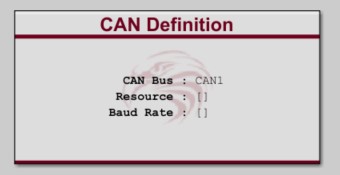Raptor:CAN Definition: Difference between revisions
Jump to navigation
Jump to search
No edit summary |
|||
| Line 6: | Line 6: | ||
== Description == | == Description == | ||
<p>This block is used to create a CAN bus resource and map it to a particular hardware I/O point. This block will generate all of the code necessary to connect and coordinate all the Raptor™ CAN blocks with the hardware CAN interface. Each CAN bus that will be used in the model must include a | <p>This block is used to create a CAN bus resource and map it to a particular hardware I/O point. This block will generate all of the code necessary to connect and coordinate all the Raptor™ CAN blocks with the hardware CAN interface. Each CAN bus that will be used in the model must include either a CAN definition block or a CAN FD definition block.</p> | ||
== Parameters == | == Parameters == | ||
Latest revision as of 13:47, 12 September 2023
Return to the main Raptor page

Description
This block is used to create a CAN bus resource and map it to a particular hardware I/O point. This block will generate all of the code necessary to connect and coordinate all the Raptor™ CAN blocks with the hardware CAN interface. Each CAN bus that will be used in the model must include either a CAN definition block or a CAN FD definition block.
Parameters
| Parameter | Type | Description |
|---|---|---|
| CAN Bus Name | String | The name of the CAN bus resource. |
| Hardware Resource | The hardware interface to use for the CAN bus. | |
| Use Custom Baud Rate | Checkbox | Whether to use a built-in baud rate (unchecked) or a custom baud rate (checked). Custom baud rates are only available for specific targets. |
| Custom Baud Rate Name | String | The name of the Custom Baud Rate block to use. Only available if "Use Custom Baud Rate" is checked. |
| Baud Rate | select | The baud rate for the CAN bus. Select from a list of predefined baud rates. |
| Enable Baud Rate Configuration at Initialization | Checkbox | Whether to use a Simulink function to configure the CAN baud rate at initialization. |
| Simulink Function Name | String | The name of the Simulink Function to use. |
| Create a new Simulink Function | Button | Create a new Simulink Function with the name given in the field above. A valid name must be entered in order to create the Simulink function. |
| Transmit Queue Size | Integer | The size of the transmit queue.
For the CAN bus used with XCP, it is recommended to choose a transmit queue size larger than the max number of lists per DAQ. |
| Receive Queue Size | Integer | The size of the receive queue. |